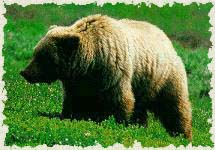In a first step toward removing the grizzly from the Endangered Species List, the U.S. Fish and Wildlife Service (FWS) has released a set of goals that falls short of what is necessary to protect their habitat in and around Yellowstone. Six conservation groups expressed strong concerns about the plan for Yellowstone, one of the last five isolated pockets of America where the grizzly bear can still be found-and an area increasingly threatened by development, oil and gas drilling, mining, logging and road building.
Scientists agree that the survival of the grizzly bear in the lower forty-eight states relies on protecting sufficient habitat. “Once the habitat is gone so is the grizzly, which has already disappeared from 99% of its former range in the lower forty-eight states,” says Louisa Wilcox of the Sierra Club Grizzly Ecosystems Project. “But unfortunately, the government’s plan would have the effect of confining Yellowstone grizzlies to an area too small to keep bears here and healthy in the long term.”
Bob Ekey of The Wilderness Society notes that, “The government plan is faulty because it sanctions habitat destruction at a rate that will squeeze grizzly bears right out of Greater Yellowstone, as if you were squeezing the last drop out of a sponge.”
Conservationists point out that habitat protections are awarded only to a portion of currently occupied range, inside a line that was drawn when grizzlies were at precariously low numbers. The plan fails to ensure a continued linkage between Yellowstone grizzlies and other grizzly bear populations, forever dooming the Yellowstone bear to isolation and related genetic and other problems. “In essence, FWS will forever keep bears locked within an ecological straight-jacket,” says Caroline Byrd of the Wyoming Outdoor Council. “And, since the grizzly functions as the ‘coal mine canary’ of the Northern Rockies, plans that harm the bear in its habitat will also hurt other wildlife, from big game to song birds.”
The plan assumes that the status quo today-in terms of quality and quantity of habitat-is adequate to ensure grizzly recovery tomorrow. But FWS fails to account for the fact that threats to grizzly bear habitat are mounting:
1. One half million acres of prime habitat are at risk of oil and gas development which would eliminate bears from areas important to recovery, if fields are fully developed.
2. Private lands comprising important habitat are being transformed into subdivisions at a runway pace.
3. Escalating use of public lands by all-terrain vehicles is reducing the habitat security for this wildland-dependent species.
4. In the last twenty-five years, resident bears have been exterminated from two grizzly management units on the Targhee Forest as a result of excessive clear cutting and road building.
5. White bark pine, which provides the grizzly with pine nuts in the fall, is imperiled by an introduced blister rust disease and global climate change.
6. In Yellowstone Lake, introduced Lake trout threatens to out-compete and predate upon Yellowstone cutthroat, potentially reducing by 80% in twenty years the native trout, an important spring grizzly food.
7. Slaughter of Yellowstone’s bison herds by government officials has greatly reduced this essential food source; at reduced herd sizes, scientists have documented decreased grizzly reproduction and increased mortality.
Conservationists emphasize that in the future grizzlies will have to rely on additional and alternative habitats when certain lands are destroyed and key native foods decline. Brian Peck of the Great Bear Foundation says, “We need to ask ourselves: are we as humans willing to display the generosity of spirit necessary to share the landscape with an unpredictable animal that needs extensive wild country?”
“Even inside the recovery area, this proposal allows for new road building when we know that roads and the activities that come with roads are precisely what kill grizzly bears,” said Tim Stevens of the Greater Yellowstone Coalition. Stevens points out FWS proposal could allow new roads and densities that are known to be lethal for grizzly bears.
In addition, experts maintain that the 200-400 remaining Yellowstone bears will be at risk of extinction in the long term if they are permanently sealed off from other grizzly ecosystems. “Unfortunately, as the FWS proposes to study the problem, new development will proceed and, key linkages, such as the Centennial Range, Gravelly’s, and Northern Wind Rivers, potentially degrading and pinching off the area from the core of the Greater Yellowstone Ecosystem,” says Pam Lichtman of the Jackson Hole Conservation Alliance. “This plan does nothing to prevent the cutting of these remaining ecological lifelines.”
In addition, the plan compounds problems that the government still has not resolved in the recovery plan, which was found to be deficient in 1995 by a Federal judge. In this plan, FWS ignores these underlying problems-and the fact that it has still never calculated how many bears are needed to remain viable in the long term, or how much habitat is needed to maintain a healthy population.
Given these deficiencies, conservationists maintain FWS should go back to the drawing board and develop a plan that will truly recover the grizzly. “And as the nature and intensity of these threats increase, it should be clear that, now more than ever, removing the grizzly from federal protection would be a mistake,” says Louisa Wilcox”Of course, this is about more than the grizzly-it is about the future of wildlife and wildlands in the West, and the integrity of world class ecosystems symbolized by the Great Bear.”

